
ICCROM_03_PublicAdvocacy_en
.pdf
Over 10 years of working with teachers, students, the media, tourists, heritage professionals, and the general public
ICCROM & Public Advocacy
Prepared by Naomi Grattan, 2004

I C C R O M a n d P u b l i c A d v o c a c y : I n t r o d u c t i o n
ICCROM and Public Advocacy
Contents
Introduction
ICCROM Projects
Youth: 1) Conservation Awareness: Save Marcus Aurelius!
2)Adopt a Monument: Save the Colosseum
3)Investigative Portfolio: The City Beneath the City
4)Student Exchange: All Roads Lead to Rome
5)Poster Competition: Stop Graffiti
6)On-site Course: The Subregional World Heritage Skill Development Course for ASPnet Students in the Arab Region
Adults: 1) Media Competition: Media Save Art Award
2) Tour: Let’s Save Our Heritage Together
Further References
Background: Cultural Heritage and Public Advocacy
Working with Media: A Brief Guide
Table: The Causes of Deterioration of Cultural Heritage
Suggested Reading and Web Resources
Prepared by Naomi Grattan. © ICCROM 2004
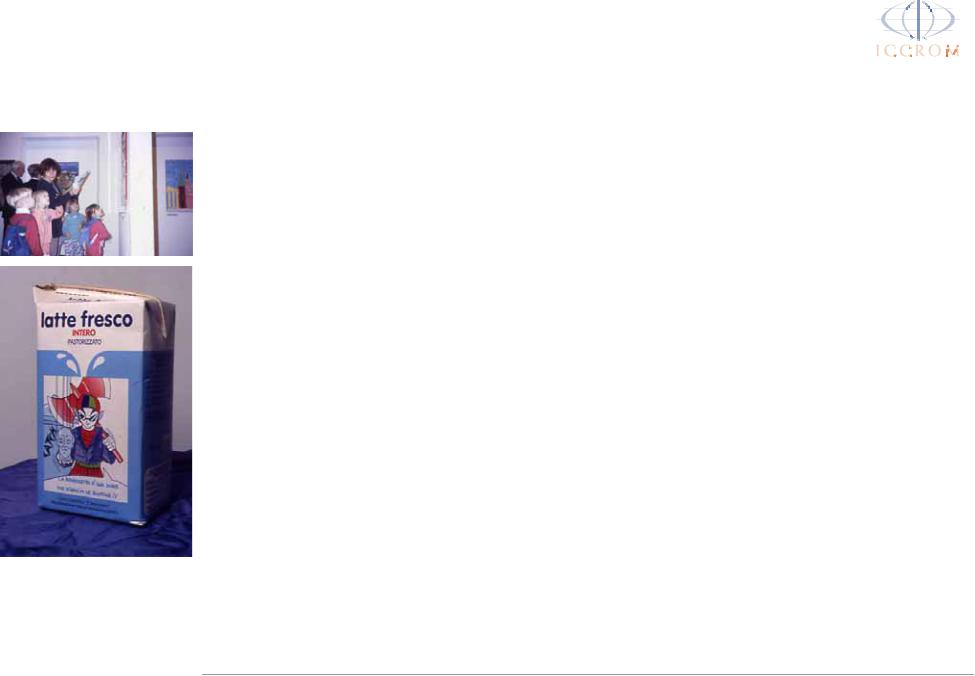
I C C R O M a n d P u b l i c A d v o c a c y : I n t r o d u c t i o n
ICCROM and Public Advocacy
Introduction
Since 1990 ICCROM has undertaken a wide variety of activities to raise public awareness about the fragility of cultural heritage, and the importance of heritage conservation.
The Media Save Art project, begun in 1991, served as a catalyst for all of ICCROM’s public awareness activities that followed. The initial event was quite extensive. It primarily consisted of a media competition with categories for television and film, press, sponsorship, and visual documentation (including t-shirts, photographs, posters, calendars etc.). There was also a children’s poster competition, and 12 roundtable discussions involving politicians, museum professionals, conservators, and other stakeholders in conservation and heritage. At the time it was clear that many people felt opening up the world of conservation to the public was extremely important to garnering both public and political support for conservation activities.
Over the years, demand for information on ICCROM’s advocacy activities has continued to grow. To respond to this interest, ICCROM has developed the following reference documentation to provide background information on a variety of public awareness projects undertaken by ICCROM and various key partners over the years, and to provide
suggested steps for undertaking similar projects.
Results and participation levels have improved with each successive project, mainly due to continually improving teacher reference materials. For Media Save Art in 1993, English Heritage provided teaching kits, which had a huge impact on the quality of work produced by English students.
Public Advocacy Reference Materials
This document set, ICCROM and Public Advocacy, is intended to provide useful historical documentation of ICCROM’s advocacy activities since the early 1990s. Each activity is described, and is followed by a list of suggested steps, based on ICCROM’s experiences, for those organizations interested in undertaking similar activities.
These materials are not a comprehensive guide to public awareness and the preservation of cultural heritage, but rather they are intended to highlight the experiences of one organization over the last ten years.
What is ICCROM?
ICCROM, the International Centre for the Study of the Preservation and Restoration of Cultural Property, was founded by UNESCO in 1956. An inter-
governmental organization based in Rome, Italy, ICCROM is concerned with every aspect of cultural property, that is, the physical testimony of human activity, thought, and artistic expression, including historic buildings and monuments, archaeological sites, historical parks, gardens, and cultural landscapes, museum collections of all kinds, and library or archival material. ICCROM’s tasks are divided into five principal areas: documentation, research, advice and recommendations, training, and heritage awareness.
ICCROM encourages the participation of organizations from the largest possible number of institutions and countries, and encourages those organizations to undertake their own programmes.
Together, ICCROM and many other heritage, education, and cultural organizations throughout the world aim to raise public awareness, particularly among young people, of these key messages:
•The world’s cultural heritage belongs to all of us;
•It is fragile, and it is disappearing all the time; and
•Together, conservation professionals and the public can safeguard it for the future.
Prepared by Naomi Grattan. © ICCROM 2004
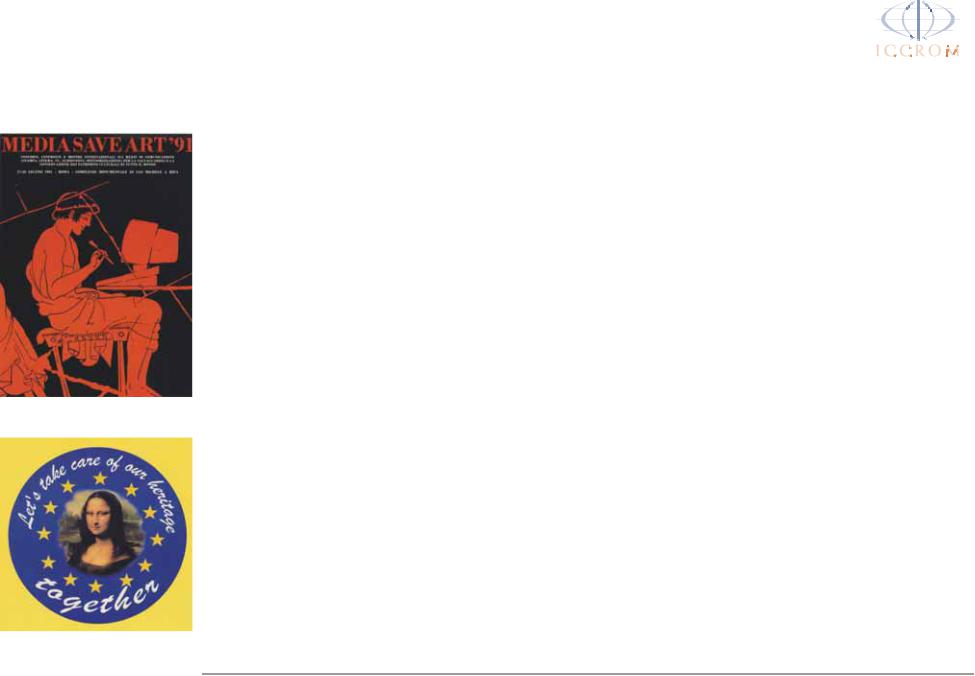
I C C R O M a n d P u b l i c A d v o c a c y : I n t r o d u c t i o n
ICCROM and Public Advocacy
ICCROM’s History of |
|
|
cultural |
|
heritage. |
|
The |
|
students |
City of Rome published their posters |
|||||||||||||||||||||||
Public Advocacy |
|
|
|
|
suddenly |
found |
themselves |
feeling |
throughout the city, and so a simple in- |
||||||||||||||||||||||||
In 1991 ICCROM added a fifth statute |
outraged |
that |
their |
cultural |
heritage |
class project |
actually |
reached |
a |
very |
|||||||||||||||||||||||
was deteriorating, and felt a burden of |
wide audience. |
|
|
|
|
|
|
|
|||||||||||||||||||||||||
to its existing mandate: |
|
|
|
|
|
|
|
|
|
|
|
||||||||||||||||||||||
|
|
|
|
responsibility to do something about it. |
|
|
|
|
|
|
|
|
|
|
|
|
|||||||||||||||||
“To |
|
support |
initiatives |
that |
Actively |
engaging |
people, |
and |
giving |
||||||||||||||||||||||||
|
|
|
|
|
|
|
|
|
|
|
|||||||||||||||||||||||
|
The Marcus Aurelius |
project, |
coupled |
them the |
opportunity |
to |
contribute |
to |
|||||||||||||||||||||||||
increase |
public awareness |
of |
|||||||||||||||||||||||||||||||
with study of media content related to |
the conservation of their |
own |
cultural |
||||||||||||||||||||||||||||||
conservation and the restoration |
|||||||||||||||||||||||||||||||||
cultural |
heritage |
highlighted |
the |
real |
heritage, |
is a |
highly effective |
way |
of |
||||||||||||||||||||||||
of cultural property”. |
|
|
|
|
|||||||||||||||||||||||||||||
|
|
|
|
need |
for |
public |
advocacy |
in |
increasing public awareness. |
|
|
|
|
||||||||||||||||||||
At the time, ICCROM had just begun to |
|
|
|
|
|||||||||||||||||||||||||||||
conservation, |
gave |
rise to |
the |
first |
ICCROM |
has |
undertaken |
activities |
to |
||||||||||||||||||||||||
seriously |
|
pursue |
public |
|
awareness |
||||||||||||||||||||||||||||
|
|
Media Save Art |
project. This project |
||||||||||||||||||||||||||||||
|
|
raise awareness among several specific |
|||||||||||||||||||||||||||||||
activities. Media Save Art generated a |
|||||||||||||||||||||||||||||||||
was then followed by many more over |
|||||||||||||||||||||||||||||||||
target groups, namely: |
|
|
|
|
|
|
|||||||||||||||||||||||||||
great |
deal |
of activity |
and |
discussion, |
|
|
|
|
|
|
|||||||||||||||||||||||
the years. |
|
|
|
|
|
|
|
|
|
|
|
|
|
|
|||||||||||||||||||
|
|
|
|
|
|
|
|
|
|
|
|
|
|
|
|
|
|
|
|
||||||||||||||
and it began |
to address |
the shocking |
|
|
|
|
|
|
|
|
• |
youth, |
|
|
|
|
|
|
|
|
|
||||||||||||
Over the |
years |
the |
school |
projects |
|
|
|
|
|
|
|
|
|
||||||||||||||||||||
absence |
of |
conservation |
issues |
in |
• |
the media, |
|
|
|
|
|
|
|
|
|||||||||||||||||||
developed two distinct phases: a study |
|
|
|
|
|
|
|
|
|||||||||||||||||||||||||
mainstream |
media. |
ICCROM’s |
first |
|
|
|
|
|
|
|
|
||||||||||||||||||||||
|
|
|
|
|
|
|
|
|
|
|
|
||||||||||||||||||||||
phase involving initial learning about a |
• |
the general adult public, and |
|
|
|
||||||||||||||||||||||||||||
activities |
were primarily basic learning |
|
|
|
|||||||||||||||||||||||||||||
particular |
conservation issue, |
followed |
|
|
|
|
|
|
|
|
|
|
|
|
|||||||||||||||||||
activities |
|
focused |
on |
raising |
public |
• |
visitors. |
|
|
|
|
|
|
|
|
|
|||||||||||||||||
|
by an |
activity |
phase |
where |
students |
|
|
|
|
|
|
|
|
|
|||||||||||||||||||
awareness |
of |
the |
fact |
that |
all |
cultural |
Today, |
after |
just |
over |
ten years |
of |
|||||||||||||||||||||
shared |
their learning |
with |
the public. |
||||||||||||||||||||||||||||||
heritage is constantly deteriorating. |
|
||||||||||||||||||||||||||||||||
|
For example, in the Stop |
Graffiti |
working with students, teachers, the |
||||||||||||||||||||||||||||||
In 1985, Save Marcus Aurelius was |
|||||||||||||||||||||||||||||||||
project, |
students |
learned |
about |
the |
media and the general public, ICCROM |
||||||||||||||||||||||||||||
the first activity aimed at school |
problems of graffiti and vandalism, as |
is turning its attention to another key |
|||||||||||||||||||||||||||||||
children. The project was intended to |
well as other threats to the |
cultural |
target group: cultural tourists. ICCROM |
||||||||||||||||||||||||||||||
investigate whether or not students |
heritage in Rome. They spent |
time |
is presently working with the publishers |
||||||||||||||||||||||||||||||
would be interested in conservation, |
talking about the value of |
cultural |
of several of the world’s best-known |
||||||||||||||||||||||||||||||
and whether an awareness of the |
heritage with experts and the damage |
travel |
|
guidebooks |
|
to |
|
include |
|||||||||||||||||||||||||
deterioration of cultural heritage would |
caused |
by graffiti, |
neglect, |
pollution |
information about |
responsible |
cultural |
||||||||||||||||||||||||||
affect how they perceived the world |
and |
other |
urban |
conservation |
tourism. |
|
|
|
|
|
|
|
|
|
|
||||||||||||||||||
around them. After giving two separate |
problems. After they had learned about |
Slowly, |
a |
general |
understanding |
that |
|||||||||||||||||||||||||||
groups |
two |
different |
tours |
– |
one |
||||||||||||||||||||||||||||
these |
issues, |
the |
students |
helped |
heritage |
is fragile, |
that it will not |
last |
|||||||||||||||||||||||||
included |
|
information |
|
about |
the |
||||||||||||||||||||||||||||
|
|
contribute to the solution. By creating |
forever, |
and that |
concerted |
efforts |
by |
||||||||||||||||||||||||||
restoration |
|
of |
Marcus |
Aurelius’ |
|||||||||||||||||||||||||||||
|
anti-graffiti posters |
students were not |
both professionals |
and the |
public |
are |
|||||||||||||||||||||||||||
equestrian statue, and the other didn’t |
|||||||||||||||||||||||||||||||||
only |
reinforcing |
their |
classroom |
required |
|
to |
ensure |
it |
endures |
is |
|||||||||||||||||||||||
– it was clear in the student responses |
|
||||||||||||||||||||||||||||||||
learning, |
but |
they |
were |
actively |
beginning |
to |
develop |
in |
the |
public |
|||||||||||||||||||||||
that |
they |
were |
highly |
affected |
by |
||||||||||||||||||||||||||||
contributing to public |
education. The |
mind. |
|
|
|
|
|
|
|
|
|
|
|||||||||||||||||||||
learning |
about |
the |
restoration |
of |
|
|
|
|
|
|
|
|
|
|
|||||||||||||||||||
|
|
|
|
|
|
|
|
|
|
|
|
|
|
|
|
|
|
|
|
|
|
||||||||||||
Prepared by Naomi Grattan. © ICCROM 2004
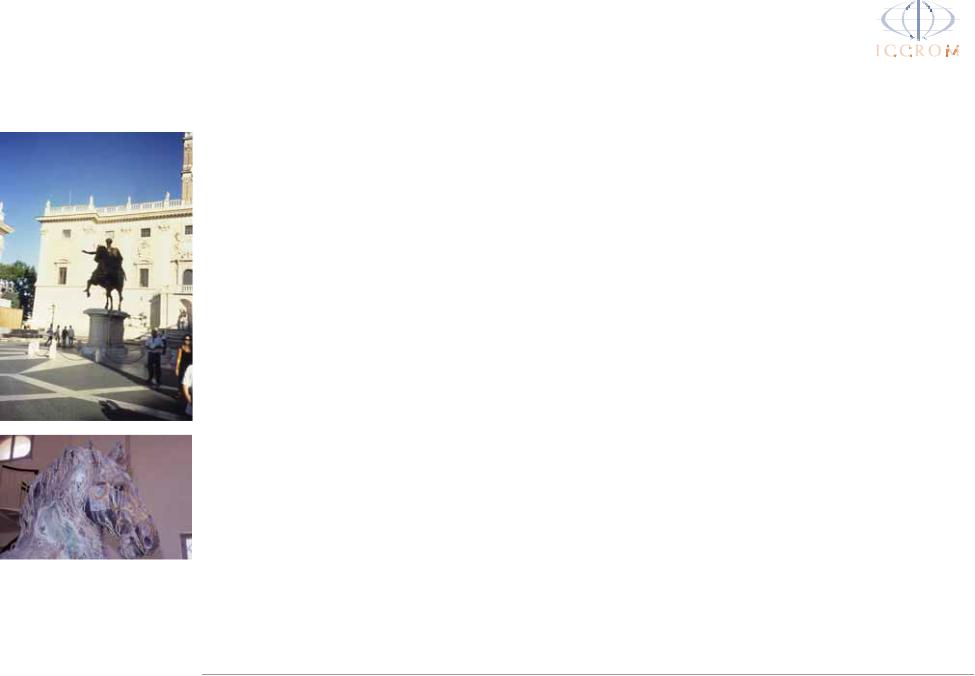
I C C R O M a n d P u b l i c A d v o c a c y : I C C R O M P r o j e c t s : Y o u t h
1) Conservation Awareness: Save Marcus Aurelius!
Project Focus
To help children develop critical awareness of the deterioration of cultural heritage and a basic knowledge of conservation.
Target Group
• Students age 7-12.
Brief Outline
Save Marcus Aurelius was a basic awareness project that exposed students to restoration projects and the general concept of conservation.
It had three major goals:
1.To make students aware of the conservation processes involved in preserving cultural heritage.
2.To help students understand what deterioration looks like, and to encourage them to suggest solutions for preserving cultural heritage.
3.To emphasize that there is no perfect solution for preserving cultural heritage, as it will eventually deteriorate completely, and to explain that every conservation decision undertaken by professionals must balance a wide variety of issues.
Background Description
In 1985, ICCROM began its first public advocacy project. Save Marcus Aurelius was initiated to find out if children would be interested in conservation, and whether learning about it would affect how they saw the cultural landscape around them.
The bronze equestrian statue of Marcus Aurelius was removed from its public pedestal in the Piazza Campidoglio, and underwent conservation and restoration throughout the 1980s. The statue had suffered considerably from pollution damage. Following its restoration, it was publicly unveiled in 1990 as part of a special exhibition about the project. A replica now stands in the piazza; the restored statue is housed in the Capitoline Museums.
In 1985, ICCROM invited two groups (a school class divided in two) of 10 yearolds to visit the statue while it was undergoing restoration at the Istituto Centrale del Restauro laboratory. Both groups learned about the historical and artistic significance of the statue. However, only one group received detailed information about the restoration project, and the conservation activities involved in stabilizing and protecting the statue. They learned about what caused the statue to deteriorate, what was done to restore the statue, how much the
project cost, and the length of time it took to complete the restoration.
After their tours, each group was asked to draw a picture about the statue and what they had learned. The group that received only historical information drew very static pictures. However, the group that received both the conservation and historical information drew much more dynamic pictures. They wanted to protect the work; several students depicted the statue under a protective dome. Other students included various damaging agents, such as pollution, weather, traffic, and vandalism that could threaten the work.
As ICCROM’s first public awareness project, it was a fairly basic enterprise. However, it remains a significant project because it revealed that students were interested in conservation and that learning about it did change their perceptions of the cultural heritage around them. Further, it showed that unless taught about it, they tend to regard cultural heritage as stable and permanently unchanging over time. The project is worth repeating as a basic introductory exercise to the world of conservation and restoration.
Prepared by Naomi Grattan. © ICCROM 2004
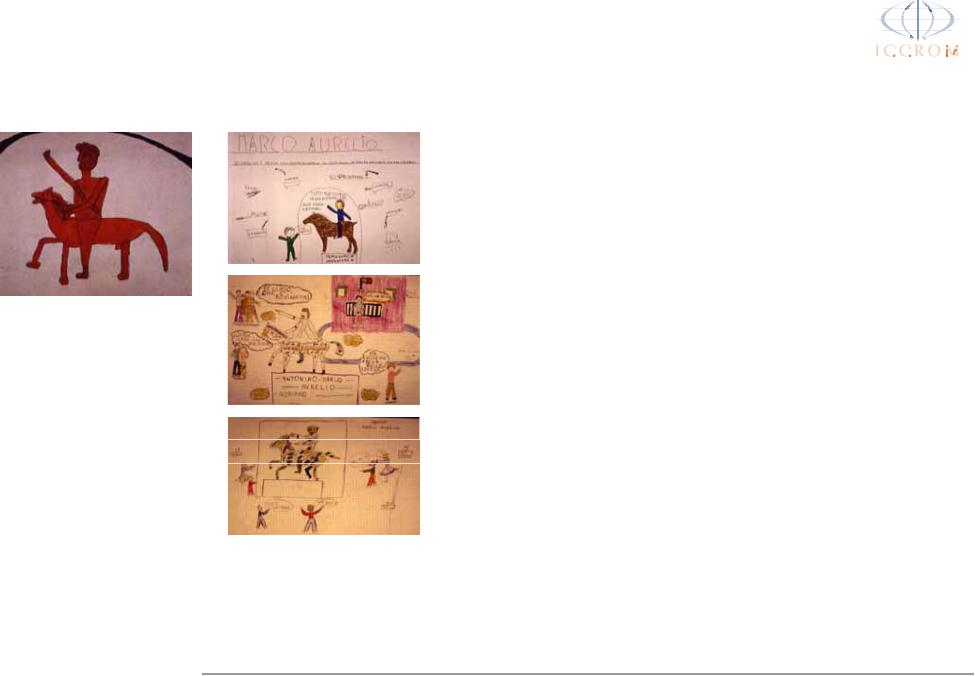
Drawing by a student who did not learn about conservation.
I C C R O M a n d P u b l i c A d v o c a c y : I C C R O M P r o j e c t s : Y o u t h
1) Conservation Awareness: Suggested Steps
Drawings by students who learned about conservation.
Before the project
•Plan a project outline, allowing sufficient time to arrange a visit to a conservation and/or restoration project that is underway. Include a talk with an expert if possible. Generally this project does not take very long to arrange and implement.
•Choose a monument or other object that is either currently being conserved or restored, or has just been treated. Students connect well with the project when it focuses on a highly recognized iconic object. For example, the Eiffel Tower, the Statue of Liberty, or the leaning tower of Pisa.
•Establish links with teachers, the conservation and/or restoration experts involved, and any other relevant agencies.
•Arrange a tour, prepare lectures, and develop other learning materials. All the materials should include a definition of restoration and conservation and why it is necessary in the specific case you’ve chosen to study. Also include the state of the object prior to treatment, what caused it to deteriorate, details of the treatment process and its results, the time, expertise, and funds required to treat the object, and, following conservation or restoration, how the
object will be protected to ensure its stability.
During the project
•Study phase: In-group activities should address the following topics, as they will help the students to understand the context of the conservation or restoration project:
•restoration and conservation,
•the object’s historical and artistic significance, and
•how the object was damaged and why the object must be restored.
•Action phase: Give the students the opportunity to talk to conservation and/or restoration experts, and if possible, to see the experts at work. Ask the students to respond by creating posters, and engaging in other group activities.
Follow-up
There are a number of follow-up activities you could do, including:
•Ask the group to identify similar objects or buildings they might know of in similar circumstances.
•Plan to do similar studies with them.
•Display the student’s work.
Prepared by Naomi Grattan. © ICCROM 2004
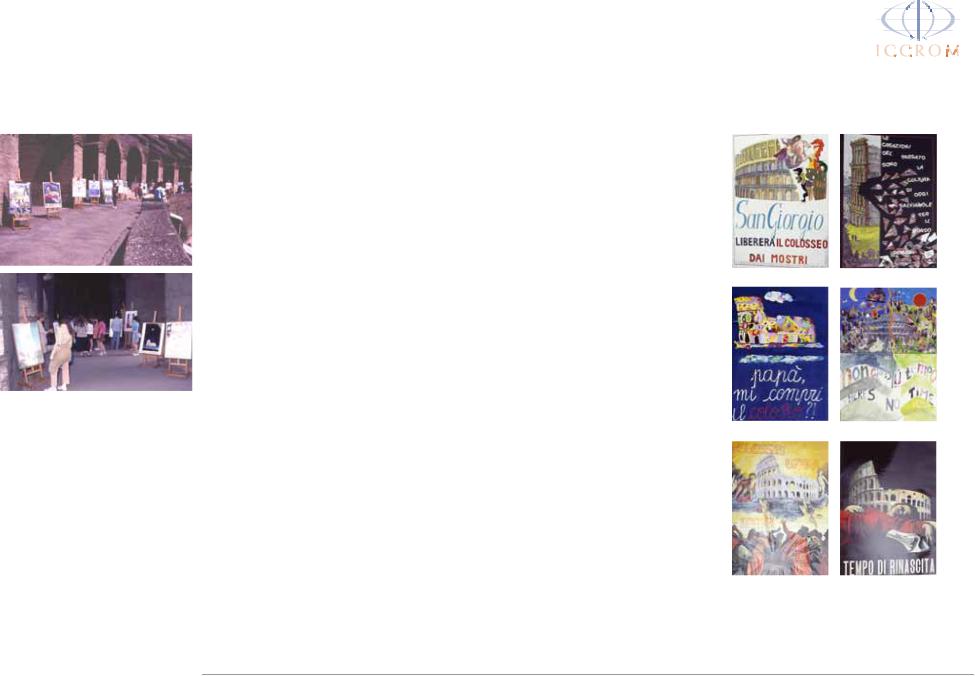
I C C R O M a n d P u b l i c A d v o c a c y : I C C R O M P r o j e c t s : Y o u t h
2) Adopt a Monument: Save the Colosseum
Project Focus
Encouraging students to raise public awareness about the deterioration of cultural heritage by undertaking a specific site or monument in need of conservation or restoration.
Target Group
• Students age 14-17.
Brief Outline
In 1992-1993 students symbolically adopted the Colosseum. They learned about its history, its cultural significance, and the state of its conservation. They visited it regularly, and became invested in its protection. Over an entire school year they undertook various projects to contribute to its preservation, and to raise public awareness about its condition.
The project had two goals:
1.To encourage students to actively contribute to the conservation of cultural heritage by raising public awareness of the issues facing a given monument.
2.To give students a basic grounding in managing a public advocacy campaign.
Background Description
Over one full school year, ten classes from an arts high school in Rome adopted the Colosseum.
They visited the site regularly, and talked with experts about the specific conservation problems facing it, including pollution and the constant vibration of traffic. The metro line runs directly beneath the Colosseum, and it is completely surrounded by roads with heavy traffic; the combination causes enough vibration to seriously damage the site each year. While one road has been closed, three remain close enough to continue to affect it. Vandalism is another large problem.
Following their in-class learning activities and their tours with conservation experts, students created posters to alert the public about the conservation problems afflicting the Colosseum. The students developed an exhibition of their work, managed all the exhibition planning, and were on hand to talk to the general public for the exhibition’s duration. Students also conducted a large-scale public questionnaire to find out how much people knew about the state of the Colosseum.
Prepared by Naomi Grattan. © ICCROM 2004
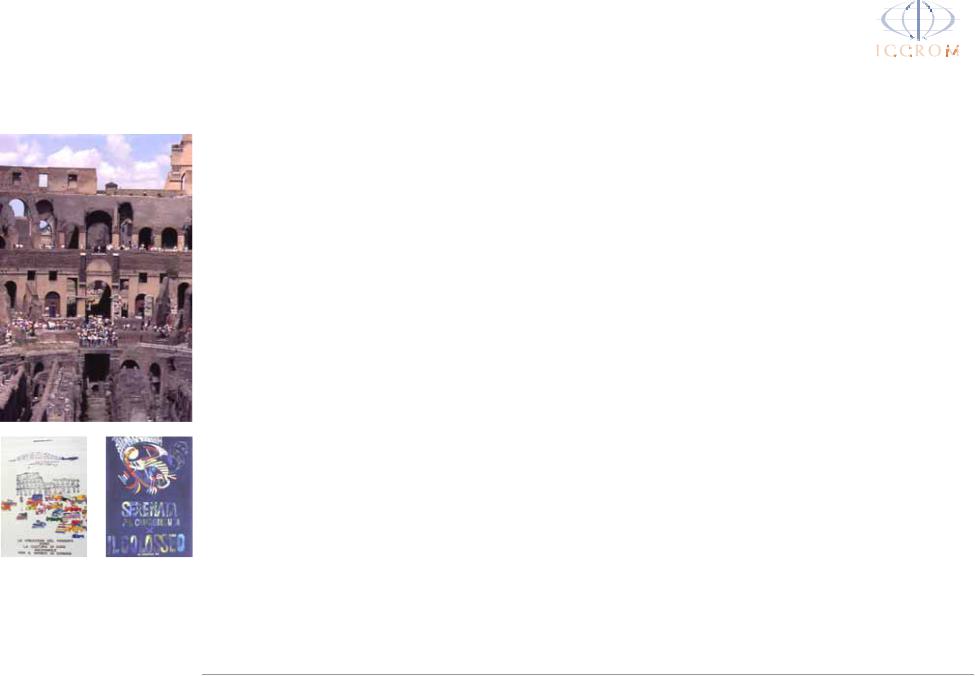
I C C R O M a n d P u b l i c A d v o c a c y : I C C R O M P r o j e c t s : Y o u t h
2) Adopt A Monument: Suggested Steps
Before the project
•Select a monument for your class to adopt. The monument could be: a building of notable architecture (church, palace, public building, city hall, station, industrial building), a sculpture (statue, fountain, tomb, bust), a garden, or an archaeological site. Ideally it should be close to your school, and artistically, historically, and/or socially interesting, as well as directly connected to local history.
•Prepare in-class activities that involve several subjects, including the historical significance of the monument, its artistic significance, and the state of its conservation.
•Make connections with conservation professionals who are involved in the care of the monument, or other similar ones. Arrange at least one special tour of the monument for your students, focusing on its conservation issues.
•Plan your timeline for the project.
During the project
•Study phase: Talk to your class about the meaning of adoption. Discuss what it means to Adopt a Monument: to symbolically appropriate the monument, to regard it as your own (or belonging to your class), to study it and get to know it, to make it known to other people, to love it, to take care of it, and to protect it.
•Discuss the role of monuments in public life, and why people build them. Learn about the monument. Conduct research across various different disciplines in the classroom.
•Action phase: Visit the monument regularly, and physically take care of it. Only under expert guidance remove encroaching vegetation, clean it, and undertake any appropriate other activities.
•Share what the class has learned with the community. Students could prepare guidebooks or websites for the public, or other reference materials. They could develop an exhibition about the monument’s state of preservation.
•Get students to try and improve the conditions of the monument – write letters to authorities, and to the media (see Further References for a guide to working with the media).
Create plays for the public to educate them about the monument and the problem of conserving cultural heritage.
Follow-up
There are a number of follow-up activities you could do, including:
•Establish a regular heritage working day for regional schools.
•Offer regular student-guided tours of the monument.
•Get the students to conduct a public questionnaire to see if their work has improved public knowledge of the monument.
Prepared by Naomi Grattan. © ICCROM 2004
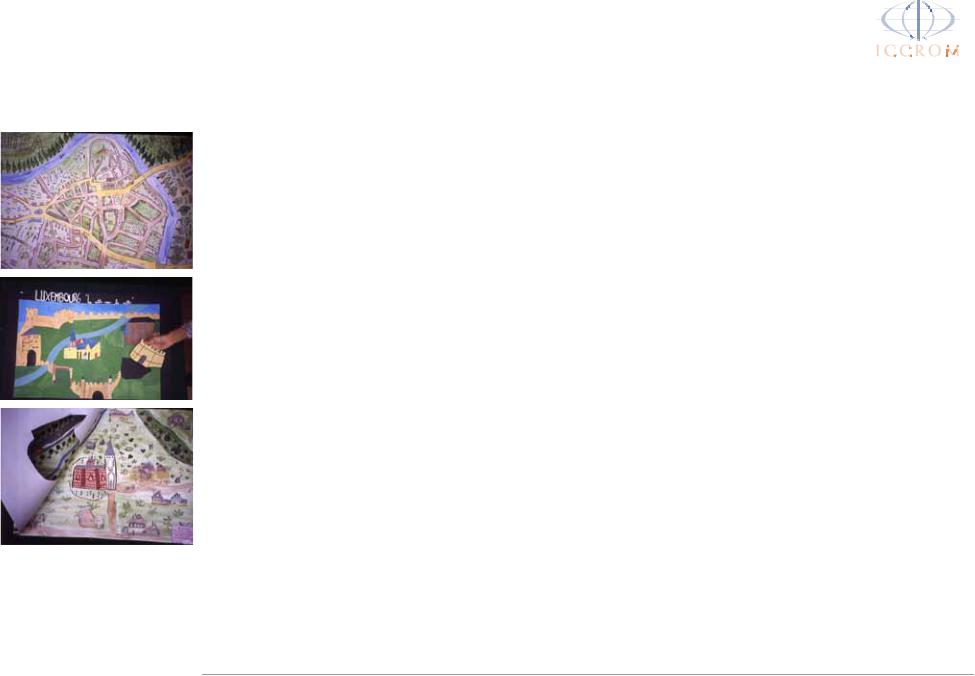
I C C R O M a n d P u b l i c A d v o c a c y : I C C R O M P r o j e c t s : Y o u t h
3) Investigative Portfolio: The City Beneath The City
Project Focus
Balancing heritage conservation and the growth and change in a city over time, focusing on urban archaeology and historical architecture.
Target Group
• Students age 7-12.
Brief Outline
A city investigation project in which students undertook various learning projects about different eras in their city across different disciplines. All their projects were collected in individual portfolios, which were then entered into a competition.
The project had four goals:
1.To make students aware of the beginnings of their cities.
2.To make students aware of the layers of cultural heritage accumulated over centuries in their cities.
3.To get students talking about balancing urban development against the conservation and management of cultural heritage.
4.To help teachers bring heritage learning alive in the classroom.
Background Description
The City Beneath the City was a joint project undertaken by ICCROM and the Council of Europe in 1995-1996, involving 25 cities from 24 different countries, 3,200 students from 154 classes, and 168 teachers.
In each city, students learned both in the classroom, and outside throughout their cities, about the cultural heritage surrounding them. They completed projects in various disciplines to learn about different historical periods in their cities. Students visited museums and archaeological sites, studied monuments, drew historical maps, conducted historical research and archaeological excavations, worked in laboratories, talked to residents of old neighbourhoods – who often shared memories and old photographs – and took their own photographs, among many other activities.
Students also discussed urban development, its positive and negative aspects, and the inevitability of change, with teachers, their parents, and other experts. It was important to discuss change over time, and how cities could achieve balance between heritage conservation and new development.
The students prepared various projects to share their learning, including guided walking tours, handbooks to specific sites, theatre productions, artworks,
and so on. Each student included all their projects in a folder – their Investigative Portfolio – and created a trail-map about their city’s heritage, which included historical monuments from several different eras. The goal was to study all visible eras in each city, not just one!
In each city all the Investigative Portfolios were entered into a competition between schools, each city then entered the winners into an international competition. Organizers at the international level received 95 submissions, and a jury made up of education and conservation experts selected the best portfolios. The criteria included creativity, depth of investigation, number of eras covered, and so on. A prize of US$2,500 was awarded in each age category: 7-9 and 10-12.
Following the competition, an exhibition of the student works toured several cities. The city of Padua, Italy, launched a poster campaign addressing the fragility of heritage.
English Heritage was a key partner, as they created the didactic material for teachers (see the Suggested Reading list in the Further References section). Support was also provided by the Associazione fra le Casse di Risparmio Italiane (the Association of Italian Savings Banks).
Prepared by Naomi Grattan. © ICCROM 2004
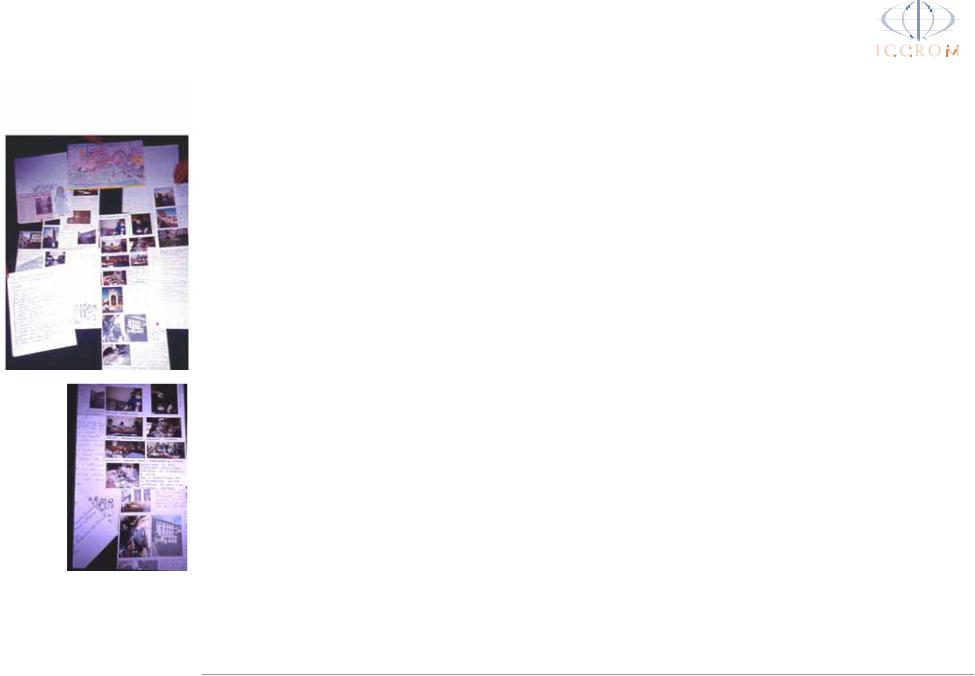
I C C R O M a n d P u b l i c A d v o c a c y : I C C R O M P r o j e c t s : Y o u t h
3) Investigative Portfolio: Suggested Steps
Before the project
•Identify a main project coordinator and determine the scope of the project, whether local, municipal, national, or international.
•Establish committees for each project section and delegate responsibilities, including: contacting and involving schools and teachers, defining project content (which eras students will examine, which sites they will visit in each city, and so on), determining classroom activities, preparing learning materials (ensuring they are ready for the beginning of the school year), and organizing guided visits and lectures.
•Plan the timeline relative to the scope of your project. It took roughly one year of planning to define the project, to choose participant cities, to prepare didactic materials, and to set competition rules. All the planning should be completed, and teachers should have the learning materials prior to the start of the school year so they can plan interdisciplinary classroom work. The project itself, including student work, the competition, and any follow-up activities took approximately one school year; each phase took about two to three months, or one term.
•Begin looking for sponsors early. Consider asking a sponsor to supply
classroom materials for creative work. You may also want to develop a media relations strategy to give the project a high public profile – that will help persuade sponsors to support it. (See Further References for a brief guide to working with media.)
•Establish relationships with other expert partners, including city councils, conservation scientists, other experts, and the relevant levels of government.
•Plan the competition, including jury selection, definition of the rules and categories, and securing prizes that will motivate the students. The jury should include both teachers and conservators. Also, set aside a space to collect and manage the entries.
During the project
• Study phase: Students learn about the history of their city and how it has changed over time. Students visit museums, monuments, and tour the city itself, discussing the changes in the classroom with teachers and heritage or conservation experts. They should note old buildings and identify their shared characteristics that distinguish them from newer buildings, such as materials, styles, and sizes. Ask
students to look for clues about who owns/owned the building.
•Action phase: Students complete various multi-disciplinary learning projects about their city, including the creation of a ‘city discovery trail’ to highlight different historical buildings, monuments, and other sites which illustrate different eras of the city’s history. Student maps should also highlight places that illustrate conservation issues to promote discussion of urban preservation.
•Competition: The jury rewards the best portfolios in each age category, focusing primarily on the quality of investigation and of presentation, and any other required elements. Consider hosting a formal awards ceremony, coupled with another cultural event if possible.
Follow-up
There are a number of follow-up activities you could do, including:
•Create an exhibition of the student projects and arrange for it to tour all participant cities.
•Discuss the project with participants to find out what could be improved for the next one.
Prepared by Naomi Grattan. © ICCROM 2004
